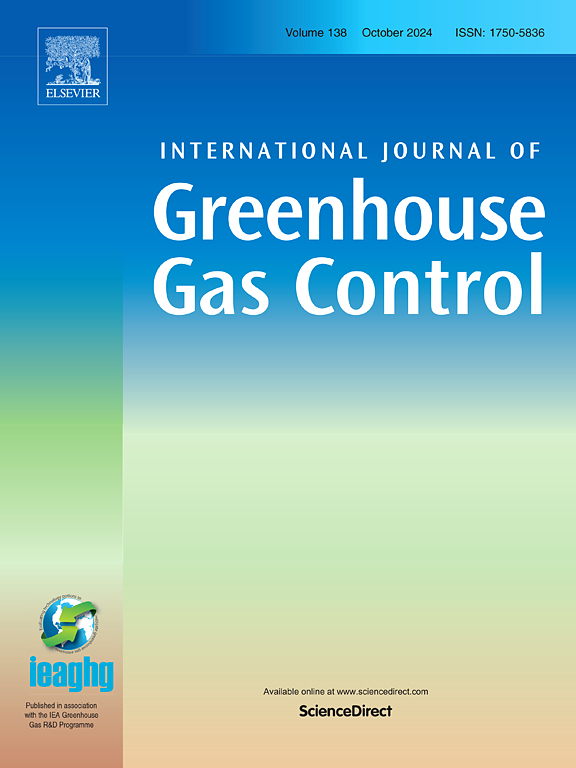深度学习辅助thm集成InSAR模型CO2储存表征和地表变形预测
IF 5.2
3区 工程技术
Q2 ENERGY & FUELS
International Journal of Greenhouse Gas Control
Pub Date : 2025-09-16
DOI:10.1016/j.ijggc.2025.104461
引用次数: 0
摘要
地质储碳地下储层的准确表征是确保储碳长期安全、降低泄漏风险的关键。该研究提出了一种新的CO₂储层表征框架,该框架将基于insar的地表变形数据与基于深度学习的方法(pix2pix)相结合,以预测地下性质,如岩石相和孔隙度。为了评估CO2注入前后的地表变形,采用了THM(热-水文-力学)模拟,并将其相应结果作为建议的基于pix2pixel的模型的输入。为了揭示所建议工作流程的鲁棒性,通过改变InSAR数据的信噪比(SNR)和观测时间段进行敏感性分析,评估其对表征性能的影响。此外,该模型还用于长期CO₂羽流和地表变形预测,使未来行为的不确定性量化成为可能。结果表明,早期观测数据提供了丰富的地下信息,但对噪声高度敏感,而后期观测数据对噪声的容忍度更高,但信息含量降低。该工作流程有效预测了CO₂羽流的长期迁移和地表变形趋势,证明了其在油藏监测中的适用性。该研究表明,将基于insar的地表变形数据与深度学习相结合,可以显著改善CO₂储层的表征。研究结果强调了优化InSAR采集频率和噪声处理策略以提高监测精度的重要性。该方法为利用地表变形数据开发基于时间序列的储层表征模型提供了基础。本文章由计算机程序翻译,如有差异,请以英文原文为准。
Deep learning-assisted THM-integrated InSAR modeling for CO2 storage characterization and surface deformation forecasting
Accurate characterization of subsurface reservoirs in geological carbon storage (GCS) is essential for ensuring long-term storage security and mitigating leakage risks. This study proposes a novel CO₂ reservoir characterization framework that integrates InSAR-based surface deformation data with a deep learning-based method (pix2pix) to predict subsurface properties, such as rock facies and porosity. To assess the surface deformation before and after CO2 injection, a THM (thermal-hydrological-mechanical) simulation is employed, and their corresponding results are used as input for the suggested pix2pix-based model. To reveal the robustness of the suggested workflow, sensitivity analysis is conducted by varying signal-to-noise ratio (SNR) of InSAR data and observation time periods, assessing their impact on characterization performance. Furthermore, the model is applied for long-term CO₂ plume and surface deformation predictions, enabling uncertainty quantification of future behavior.
The results show that early-stage observation data provide rich subsurface information but are highly sensitive to noise, whereas later observations exhibit greater tolerance to noise but reduced information content. The suggested workflow effectively predicts long-term CO₂ plume migration and surface deformation trends, demonstrating its applicability for reservoir monitoring. This study demonstrates that integrating InSAR-based surface deformation data with deep learning significantly improves CO₂ reservoir characterization. The findings highlight the importance of optimizing InSAR acquisition frequency and noise-handling strategies to enhance monitoring accuracy. The proposed approach provides a foundation for developing time-series-based reservoir characterization models using surface deformation data.
求助全文
通过发布文献求助,成功后即可免费获取论文全文。
去求助
来源期刊
CiteScore
9.20
自引率
10.30%
发文量
199
审稿时长
4.8 months
期刊介绍:
The International Journal of Greenhouse Gas Control is a peer reviewed journal focusing on scientific and engineering developments in greenhouse gas control through capture and storage at large stationary emitters in the power sector and in other major resource, manufacturing and production industries. The Journal covers all greenhouse gas emissions within the power and industrial sectors, and comprises both technical and non-technical related literature in one volume. Original research, review and comments papers are included.

 求助内容:
求助内容: 应助结果提醒方式:
应助结果提醒方式:


